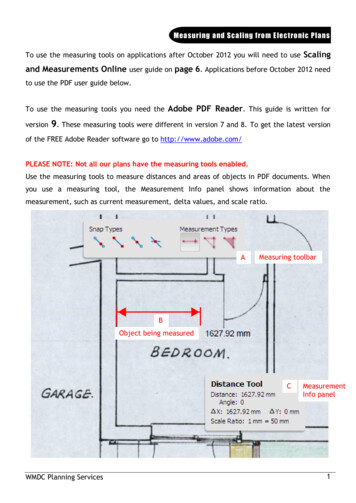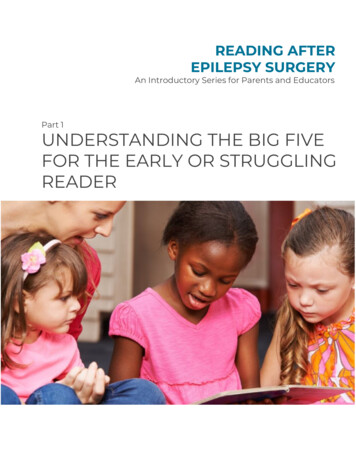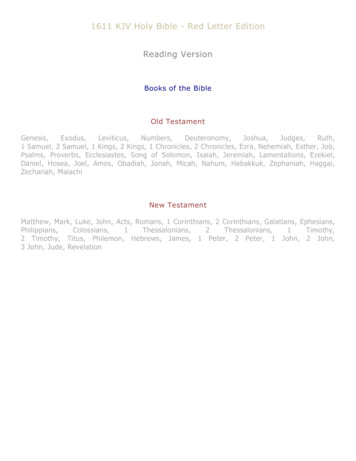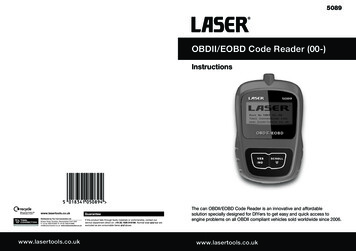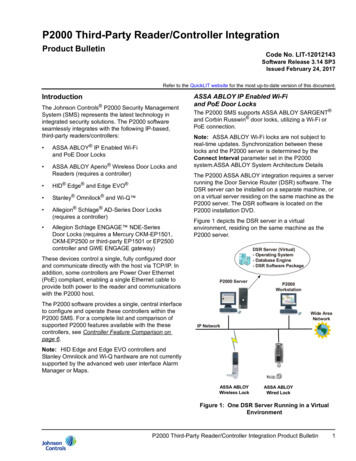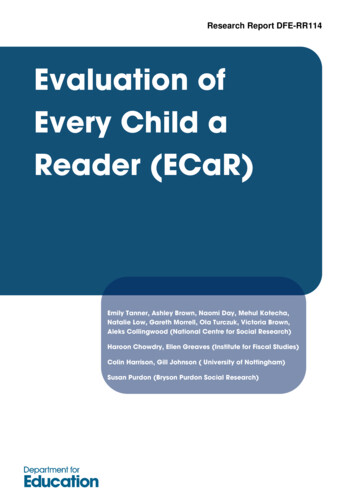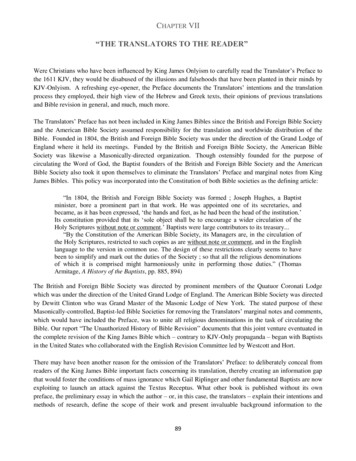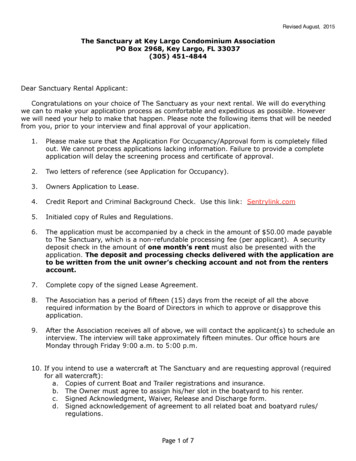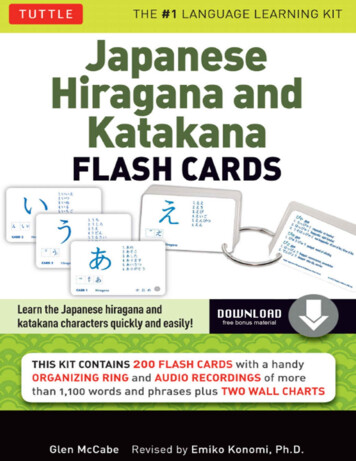
Transcription
Dear Reader: In order to view all colored text and non-English textaccurately, please ensure that the PUBLISHER DEFAULTS SETTING onyour reading device is switched to ON. This will allow you to view all nonEnglish characters and colored text in this book. —Tuttle Publishing
Dr. Emiko Konomi received her Ph.D. in linguistics from Cornell University.She teaches Japanese in the World Languages and Literatures department ofPortland State University.Glen McCabe has studied the Japanese language and business subjects at theUniversity of Waikato, the Kansai Gaidai in Osaka, the University ofCanterbury, and the Australian National University.Published by Tuttle Publishing, an imprint of Periplus Editions (HK) Ltd.www.tuttlepublishing.comCopyright 2012 by Periplus Editions (HK) LtdSpecial thanks to Timothy G. Stout for permission to use mnemonic phrases from his Japanese Hiragana &Katakana for Beginners, ISBN 978-4-8053-1144-8.All rights reserved. No part of this publication may be reproduced or utilized in any form or by any means,electronic or mechanical, including photocopying, recording, or by any information storage and retrievalsystem, without prior written permission from the publisher.ISBN: 978-1-4629-1472-2 (ebook)Distributed byNorth America, Latin America & EuropeTuttle Publishing364 Innovation DriveNorth Clarendon, VT 05759-9436 U.S.A.Tel: 1 (802) 773-8930Fax: 1 (802) ing.comJapanTuttle PublishingYaekari Building, 3rd Floor5-4-12 Osaki, Shinagawa-kuTokyo 141 0032Tel: (81) 3 5437-0171Fax: (81) 3 5437-0755sales@tuttle.co.jpwww.tuttle.co.jpAsia PacificBerkeley Books Pte. Ltd.
61 Tai Seng Avenue #02-12Singapore 534167Tel: (65) 6280-1330Fax: (65) First edition15 14 13 12543211202CTPrinted in ChinaTUTTLE PUBLISHING is a registered trademark of Tuttle Publishing, a division of Periplus Editions(HK) Ltd.
ContentsQuick Guide: What’s On the CardsThe Hiragana CharactersThe Katakana CharactersIntroductionHow to Use the Cards: Best Learning StrategiesReading and RememberingPronunciation and ListeningRepetitionWritingUsing the Cards Your WayFinally Index of Cards in Numeric OrderEnglish-Japanese IndexCards HiraganaCARD 1 HiraganaCARD 2 HiraganaCARD 3 HiraganaCARD 4 HiraganaCARD 5 HiraganaCARD 6 HiraganaCARD 7 HiraganaCARD 8 Hiragana
CARD 9 HiraganaCARD 10 HiraganaCARD 11 HiraganaCARD 12 HiraganaCARD 13 HiraganaCARD 14 HiraganaCARD 15 HiraganaCARD 16 HiraganaCARD 17 HiraganaCARD 18 HiraganaCARD 19 HiraganaCARD 20 HiraganaCARD 21 HiraganaCARD 22 HiraganaCARD 23 HiraganaCARD 24 HiraganaCARD 25 HiraganaCARD 26 HiraganaCARD 27 HiraganaCARD 28 HiraganaCARD 29 HiraganaCARD 30 HiraganaCARD 31 HiraganaCARD 32 HiraganaCARD 33 HiraganaCARD 34 HiraganaCARD 35 HiraganaCARD 36 HiraganaCARD 37 HiraganaCARD 38 HiraganaCARD 39 HiraganaCARD 40 HiraganaCARD 41 Hiragana
CARD 42 HiraganaCARD 43 HiraganaCARD 44 HiraganaCARD 45 HiraganaCARD 46 HiraganaCARD 47 HiraganaCARD 48 HiraganaCARD 49 HiraganaCARD 50 HiraganaCARD 51 HiraganaCARD 52 HiraganaCARD 53 HiraganaCARD 54 HiraganaCARD 55 HiraganaCARD 56 HiraganaCARD 57 HiraganaCARD 58 HiraganaCARD 59 HiraganaCARD 60 HiraganaCARD 61 HiraganaCARD 62 HiraganaCARD 63 HiraganaCARD 64 HiraganaCARD 65 HiraganaCARD 66 HiraganaCARD 67 HiraganaCARD 68 HiraganaCARD 69 HiraganaCARD 70 HiraganaCARD 71 HiraganaCARD 72 HiraganaCARD 73 HiraganaCARD 74 Hiragana
CARD 75 HiraganaCARD 76 HiraganaCARD 77 HiraganaCARD 78 HiraganaCARD 79 HiraganaCARD 80 HiraganaCARD 81 HiraganaCARD 82 HiraganaCARD 83 HiraganaCARD 84 HiraganaCARD 85 HiraganaCARD 86 HiraganaCARD 87 HiraganaCARD 88 HiraganaCARD 89 HiraganaCARD 90 HiraganaCARD 91 HiraganaCARD 92 HiraganaCARD 93 HiraganaCARD 94 HiraganaCARD 95 HiraganaCARD 96 HiraganaCARD 97 HiraganaCARD 98 HiraganaCARD 99 HiraganaCARD 100 HiraganaCards KatakanaCARD 101 KatakanaCARD 102 KatakanaCARD 103 KatakanaCARD 104 KatakanaCARD 105 Katakana
CARD 106 KatakanaCARD 107 KatakanaCARD 108 KatakanaCARD 109 KatakanaCARD 110 KatakanaCARD 111 KatakanaCARD 112 KatakanaCARD 113 KatakanaCARD 114 KatakanaCARD 115 KatakanaCARD 116 KatakanaCARD 117 KatakanaCARD 118 KatakanaCARD 119 KatakanaCARD 120 KatakanaCARD 121 KatakanaCARD 122 KatakanaCARD 123 KatakanaCARD 124 KatakanaCARD 125 KatakanaCARD 126 KatakanaCARD 127 KatakanaCARD 128 KatakanaCARD 129 KatakanaCARD 130 KatakanaCARD 131 KatakanaCARD 132 KatakanaCARD 133 KatakanaCARD 134 KatakanaCARD 135 KatakanaCARD 136 KatakanaCARD 137 KatakanaCARD 138 Katakana
CARD 139 KatakanaCARD 140 KatakanaCARD 141 KatakanaCARD 142 KatakanaCARD 143 KatakanaCARD 144 KatakanaCARD 145 KatakanaCARD 146 KatakanaCARD 147 KatakanaCARD 148 KatakanaCARD 149 KatakanaCARD 150 KatakanaCARD 151 KatakanaCARD 152 KatakanaCARD 153 KatakanaCARD 154 KatakanaCARD 155 KatakanaCARD 156 KatakanaCARD 157 KatakanaCARD 158 KatakanaCARD 159 KatakanaCARD 160 KatakanaCARD 161 KatakanaCARD 162 KatakanaCARD 163 KatakanaCARD 164 KatakanaCARD 165 KatakanaCARD 166 KatakanaCARD 167 KatakanaCARD 168 KatakanaCARD 169 KatakanaCARD 170 KatakanaCARD 171 Katakana
CARD 172 KatakanaCARD 173 KatakanaCARD 174 KatakanaCARD 175 KatakanaCARD 176 KatakanaCARD 177 KatakanaCARD 178 KatakanaCARD 179 KatakanaCARD 180 KatakanaCARD 181 KatakanaCARD 182 KatakanaCARD 183 KatakanaCARD 184 KatakanaCARD 185 KatakanaCARD 186 KatakanaCARD 187 KatakanaCARD 188 KatakanaCARD 189 KatakanaCARD 190 KatakanaCARD 191 KatakanaCARD 192 KatakanaCARD 193 KatakanaCARD 194 KatakanaCARD 195 KatakanaCARD 196 KatakanaCARD 197 KatakanaCARD 198 KatakanaCARD 199 KatakanaCARD 200 Katakana
How to Download the Bonus Material of this Book.1. You must have an internet connection.2. Click the link below or copy paste the URL to your -contentFor support email us at info@tuttlepublishing.com.
Quick Guide: What’s On the CardsThe front of each card shows the card number in the set, the kanacharacter itself, and the related words using that kana. The strokeorder for writing it appears in the small boxes.After the 46 basic hiragana are covered, the next cards introducethe “voiced” and “combined” hiragana. Cards 101-200 introduce thekatakana in the same way. You’ll see that the combined-sound cardscontain, instead of stroke order, a row of blank boxes on which youmay write the correct stroke ordering if you wish; simply refer to therelevant earlier cards.At the bottom, a note using a “does not equal” sign ( ) may pointout other characters that beginners sometimes confuse with this kana,to help you avoid making such errors.The back of the card tells you the reading of the kana inromanization, and the romanizations and English meanings of therelated words. There are usually 6 related words per card.We’ve chosen words that are simple and memorable, yet usable—that is, words that are encountered in everyday life in Japan. The aim
here is to move quickly beyond learning single characters, and beginto apply them in easy-to-use, real-life vocabulary.The mnemonic phrase and image offer you a way to quicklyremember the character and its pronunciation. Keep in mind that therole of mnemonics in learning is very personal; you may think upadditional mnemonics that will work well for you.
The Basic 46 Hiragana Charactersあaか kaさ saた taな naは ha*ま maや yaら raわ waんnいiき kiし shiち chiに niひ hiみ miうuくkuす suつ tsuぬ nuふ fuむ muゆ yuる ruりriえeけ keせ seて teね neへ he*め meれ reおoこkoそ soとtoの noほ hoも moよ yoろ roを o っ (small tsu: double consonant)* These characters are also used as grammatical particles; they arepronounced differently then. See cards 26 and 29. Only used as a grammatical particle—not to spell words.Additional Hiragana Charactersが gaざ zaだ daぎ giじ jiぢ ji*ぐ guず zuづ zu*げ geぜ zeで deご goぞ zoどdo
ば baぱ paび biぴ piぶ buぷ puべ beぺ peぼ boぽ po* “ji” and “zu” are usually written with じ and ず.きゃ kyaしゃ shaちゃ chaにゃ nyaひゃ hyaみゃ myaりゃ ryaぎゃ gyaじゃ jaぢゃ ja*びゃ byaぴゃ pyaきゅ kyuしゅ shuちゅ chuにゅ nyuひゅ hyuみゅ myuりゅ ryuぎゅ gyuじゅ juぢゅ ju*びゅ byuぴゅ pyuきょ kyoしょ shoちょ choにょ nyoひょ hyoみょ myoりょ ryoぎょ gyoじょjoぢょ jo*びょ byoぴょ pyo* “ja,” “ju” and “jo” are usually written with じゃ, じゅand じょ.
The Basic 46 Katakana Charactersアaカ kaサ saタ taナ naハ ha*マ maヤ yaラ raワ waンnイiキ kiシ shiチ chiニ niヒ hiミ miリriウuクkuス suツ tsuヌ nuフ fuム muユ yuル ruエeケ keセ seテ teネ neへ he*メ meレ reオoコ koソ soトtoノ noホ hoモ moヨ yoロ roヲ o * These characters are also used as grammatical particles; they arepronounced differently then. Only used as a grammatical particle—not to spell words.Additional Katakana Charactersガ gaザ zaダ daバ baパ paギ giジ ji/ziヂ jiビ biピ piグ guズ zuヅ zuブ buプ puゲ geゼ zeデ deべ beぺ peゴ goゾ zoド doボ boポ po
キャ kyaシャ shaチャ chaニャ nyaヒャ hyaシュ shuチュ chuキュ kyuシェ she*チェ cheニュ nyuヒュ hyuキョ kyoショ shoチョ choニョ nyoヒョ hyoミュ myuリュ ryuミョ myoリョ ryo* Innovative pronunciationミャ myaリャ ryaギャ gyaジャ jaギュ gyuジュ juジェ je*ギョgyoジョ jo* Innovative pronunciationビャ byaピャ pyaビュ byuピュ pyuビョ byoピョ pyoInnovative Pronunciationsティ tiディ diフア faフィ fiツア tsaウィ wiヴア vaヴィ viフュ fyuツィ tsiウェ weヴ vuテュ tuデュ duフェ feフオ foツェ tseウオ woヴェ veヴオ vo
IntroductionWelcome! This set of flash cards, with its accompanying wall chartsand audio disc, is designed to supplement your study of writtenJapanese. This set will help you master hiragana and katakana.Japanese is written using 3 types of symbols. One type is the kanji(symbols that were adopted from the Chinese language). The othertype, kana, are phonetic symbols. There are two different kana“alphabets,” so to speak, called hiragana and katakana. Hiragana isused to represent some nouns, all particles, inflectional endings of allverbs and adjectives, and all forms of the copula (desu, deshita).Katakana is used primarily to write words borrowed from Westernlanguages.This comprehensive set includes the 110 syllabic units (i.e., mora)in hiragana and special pronunciation for some hiragana (particles,double consonants). Also included are the same syllabic units plusseveral special representations for innovative pronunciation inkatakana.Each card features an individual kana character and six examplewords that include the character. (The exceptions are the lesser-usedkana that have fewer than six examples in widespread or relevantcurrent use.) Most examples are typically written in kana only, as inauthentic use, but there are cases where words typically written inkanji, or a combination of kanji and kana, are provided. Words areselected on the basis of how common and practical they are, and areordered by complexity level.
How to Use the Cards: Best Learning StrategiesThe flash cards work on the same principle as that used to teachJapanese children their Japanese, in that they begin first with teachingthe hiragana (used for native Japanese words), followed by thekatakana (for words of imported origins, including those with adistinctive Japanese flavor, like bebīkā, “a stroller/pram”).The organizing ring allows you to select and group the cardshowever works best for you. You can conveniently carry with you thespecific cards you’re currently working on—take them to work, onerrands, and so on. See more below on taking advantage of youreveryday “down time” to learn!Reading and RememberingThe front of each card shows the card number in the set, the kanacharacter itself, and the related words using that kana. The back of thecard offers you a mnemonic to help in learning it, and gives thereading of the kana in romanization, along with the related words’romanizations and English meanings. Some cards include importantlearning tips as well. After you succeed in initially grasping the kana,you’ll of course place your focus on the Japanese text itself—that is,the front of the card—flipping to the back of the card only to checkyour progress, or whenever you get stuck and need a reminder.The mnemonic phrase and image offer you a way to quicklyremember the character and its pronunciation.As mentioned earlier, keep in mind that mnemonics work in a verypersonal way. You may think up additional mnemonics that will workwell for you.Don’t forget to put the wall charts up where you’ll frequently seethem. Use them as a reminder to practice and review.Pronunciation and Listening
It is ideal if you begin to learn to read Japanese after having alreadylearned some of the spoken language. This follows the same principleas that of Japanese children learning how to read after they’re alreadyspeaking. For the student who has not had such instruction, it isimportant to learn the Japanese pronunciation represented by theromanized symbols by hearing them read by a native speaker, or bylistening to the accompanying audio files. The audio disc in this setallows you to hear and repeat all the kana, and the examplewords/phrases. As you study each card, listen, repeat, and listen again!Saying the words out loud helps you to learn them, as well aspolishing your Japanese pronunciation, so don’t be shy about it.RepetitionRepetition is key in learning a language. It improves memory andfluency, builds up confidence, and helps with application. Werecommend that you move beyond an isolated character and practicerecognizing it in meaningful words as soon as possible. This helpsdevelop your scanning skills, which is essential for reading.At the beginning, you won’t know many kana, so you may notrecognize the others that form the related words. Don’t worry! Justwork through the cards covering the basic hiragana and katakana,reviewing the characters you have already covered, and noticing thekana you know in the related words. You will start recognizing moreand more.“Looping back” to previously studied cards is an essential part ofremembering characters. We suggest that after covering three cards,you loop back to the first two before moving on to the fourth, andafter covering six cards, shuffle all six cards and see if you canidentify each. You can choose your own pace to work at, but makesure you “loop back” frequently and avoid “linear” learning.Writi
Dear Reader: In order to view all colored text and non-English text accurately, please ensure that the PUBLISHER DEFAULTS SETTING on your reading device is switched to ON.

